|
|
Week #3, 18-24.September, 2005
|
Allegheny River by Canoe: A Different Way to See the River |
| |
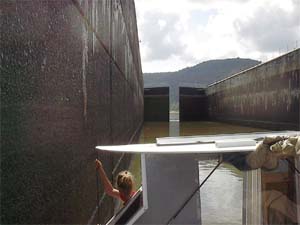 We were up early Sunday morning because we were hoping to get through five locks in one afternoon. The locks on the upper Allegheny are only open on the weekends for recreational purposes since there is little commercial traffic in the area, so we had a lot of ground to cover. It was a little after noon when we arrived at the first lock and pulled the rope that sounds a bell that alerts the lockmaster of a waiting boat. There was no response, so we pulled up to investigate and found that the operator had yet to arrive. A very friendly lockmaster showed up a little before one and apologized for his tardiness. He patiently delivered a quick lock tutorial and we were off. Or down, really. He first had to fill the chamber with water in order to get it at the same level as the upper part of the river. Then, very slowly, the doors opened. A light system very similar to stoplights is posted right next to the lock doors, and when the green light glows, it serves as the cue to enter the lock. When we got the signal, we undid our lines and headed for the lock. This lock is a little bit different from all other locks on the Upper Allegheny in that instead of using a line from the boat, ropes are provided; we simply had to hold on and slide our hands down the rope as the water level decreased. Once we were securely inside the lock, the doors were shut and the water level quickly started to drop. This lock was also special in that it is the deepest lock we have gone through so far. As you can see from the picture, the boat descended about 24 feet. In the photo above, Aimee is at the bow of the boat holding onto the lock lines as the door opens to leave the lock and proceed down the lower part of the river. We were up early Sunday morning because we were hoping to get through five locks in one afternoon. The locks on the upper Allegheny are only open on the weekends for recreational purposes since there is little commercial traffic in the area, so we had a lot of ground to cover. It was a little after noon when we arrived at the first lock and pulled the rope that sounds a bell that alerts the lockmaster of a waiting boat. There was no response, so we pulled up to investigate and found that the operator had yet to arrive. A very friendly lockmaster showed up a little before one and apologized for his tardiness. He patiently delivered a quick lock tutorial and we were off. Or down, really. He first had to fill the chamber with water in order to get it at the same level as the upper part of the river. Then, very slowly, the doors opened. A light system very similar to stoplights is posted right next to the lock doors, and when the green light glows, it serves as the cue to enter the lock. When we got the signal, we undid our lines and headed for the lock. This lock is a little bit different from all other locks on the Upper Allegheny in that instead of using a line from the boat, ropes are provided; we simply had to hold on and slide our hands down the rope as the water level decreased. Once we were securely inside the lock, the doors were shut and the water level quickly started to drop. This lock was also special in that it is the deepest lock we have gone through so far. As you can see from the picture, the boat descended about 24 feet. In the photo above, Aimee is at the bow of the boat holding onto the lock lines as the door opens to leave the lock and proceed down the lower part of the river.
|
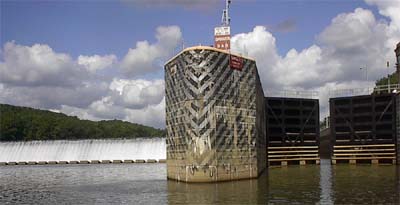 As the Libelula left the lock we got a good view of the water flowing down the dam and the closing lock doors. Boaters have to be careful going downriver where locks and dams are present because the dams can blend into the river. It is designed so that water simply spills over the side of a wall, and if one is not looking closely, it can look like the river is just continuing to flow. It is especially tricky since the locks, where the boats have to enter to pass down the river, are on the side of the dam next to the edge of the river. Luckily, signs are posted that warn boats of an approaching dam and the whole of the river near the dam is blocked off with buoys--except, of course, the little strip of water that leads to the locks. As the Libelula left the lock we got a good view of the water flowing down the dam and the closing lock doors. Boaters have to be careful going downriver where locks and dams are present because the dams can blend into the river. It is designed so that water simply spills over the side of a wall, and if one is not looking closely, it can look like the river is just continuing to flow. It is especially tricky since the locks, where the boats have to enter to pass down the river, are on the side of the dam next to the edge of the river. Luckily, signs are posted that warn boats of an approaching dam and the whole of the river near the dam is blocked off with buoys--except, of course, the little strip of water that leads to the locks.
|
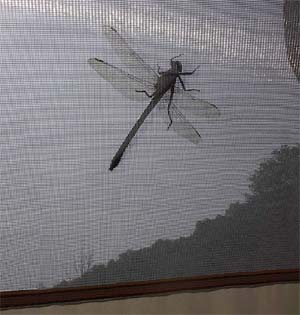 After passing through the lock, we looked at the time and realized that we were going to miss our window of opportunity to get through the other four locks that day unless we picked up some speed. With great reluctance, we dismounted the bikes, dropped the motor into the water, and in short order arrived at the second lock. All proceeded as planned until...the motor began to sputter just a few miles upriver from Lock #7 at Kittanning, which would have been our third lock of the day. A quick check of the fuel tank showed that the motor was not as fuel efficient as had been predicted by the mechanic: there was only a little bit of gasoline left. We hopped back on the bikes, but our progress was quite slow. The presence of dams severely limit the free movement of water, which causes the river to "pool" out, resulting in little to no flow in the river when there isn't much rain. Faced with the facts that we were moving quite slowly and the dams were going to be closed for the week, we decided to pedal to the nearest launch ramp, which was up Cowanshannock Creek in Gosford, and take the boat out of the water. A visit from a dragonfly resting atop the tent eased the frustrations we had about our current predicament. After passing through the lock, we looked at the time and realized that we were going to miss our window of opportunity to get through the other four locks that day unless we picked up some speed. With great reluctance, we dismounted the bikes, dropped the motor into the water, and in short order arrived at the second lock. All proceeded as planned until...the motor began to sputter just a few miles upriver from Lock #7 at Kittanning, which would have been our third lock of the day. A quick check of the fuel tank showed that the motor was not as fuel efficient as had been predicted by the mechanic: there was only a little bit of gasoline left. We hopped back on the bikes, but our progress was quite slow. The presence of dams severely limit the free movement of water, which causes the river to "pool" out, resulting in little to no flow in the river when there isn't much rain. Faced with the facts that we were moving quite slowly and the dams were going to be closed for the week, we decided to pedal to the nearest launch ramp, which was up Cowanshannock Creek in Gosford, and take the boat out of the water. A visit from a dragonfly resting atop the tent eased the frustrations we had about our current predicament.
|
 We foolishly thought that we had the situation under control, but the fates had other plans. Early the next morning after Morgan took his bike off of the boat, put some wheels on it, and headed off to retrieve the car and trailer which was parked about 25 miles upstream, Aimee heard some noises outside the boat and looked out to find a small team of Pennsylvania Fish and Game Commission employees hard at work unloading an earthmover and temporary fences. Upon further investigation, she found that they were there to tear up the ramp and replace it with a new one. It did look like a new ramp was in order, but the timing was most inconvenient. Luckily, the workers were sympathetic to our story and agreed to wait until Morgan had returned with the trailer. Meanwhile, the tire on Morgan's bike had popped and been torn to shreds about three miles from the car. He happened to be biking beside a local, however, who kindly offered to come back and collect Morgan with his car, which he did. Just as soon as Morgan arrived back to the boat with the trailer in tow, we hauled the boat out of the water. As the above picture shows, the next moment the crew was there with the earthmover, tearing the ramp up. What timing! We made the decision to return to Morgan's house in Somerset, PA in order to make a number of modifications that would hopefully help the boat move more efficiently through the water and increase our speed. We foolishly thought that we had the situation under control, but the fates had other plans. Early the next morning after Morgan took his bike off of the boat, put some wheels on it, and headed off to retrieve the car and trailer which was parked about 25 miles upstream, Aimee heard some noises outside the boat and looked out to find a small team of Pennsylvania Fish and Game Commission employees hard at work unloading an earthmover and temporary fences. Upon further investigation, she found that they were there to tear up the ramp and replace it with a new one. It did look like a new ramp was in order, but the timing was most inconvenient. Luckily, the workers were sympathetic to our story and agreed to wait until Morgan had returned with the trailer. Meanwhile, the tire on Morgan's bike had popped and been torn to shreds about three miles from the car. He happened to be biking beside a local, however, who kindly offered to come back and collect Morgan with his car, which he did. Just as soon as Morgan arrived back to the boat with the trailer in tow, we hauled the boat out of the water. As the above picture shows, the next moment the crew was there with the earthmover, tearing the ramp up. What timing! We made the decision to return to Morgan's house in Somerset, PA in order to make a number of modifications that would hopefully help the boat move more efficiently through the water and increase our speed.
|
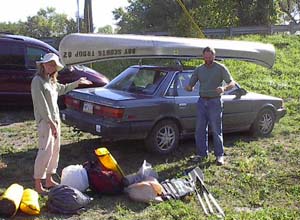 Before the modification work could begin in earnest, however, we wanted to cover some of the river that we had had to miss during the past week due to shallow water. The fourth grade teacher in Tionesta, Jim Knauff, had mentioned that we might be able to borrow his leaky canoe for such a venture, and a quick phone called proved that he was good on his word. Tuesday morning we visited the two schools along the river we had scheduled for that week in Freeport and Tarentum, PA and in the afternoon headed back up to Tionesta. Jim and his family treated us to a delightful evening, and in an interesting turn of events, he and his friend Ashley Sweda located a non-leaky canoe for us to borrow from the Tionesta Boy Scout troop #82; the same troop that we had stopped to visit the week before! Early the next morning, Ashley drove us up to Tidioute so that we could begin our journey where we first had to take the boat out of the water. In the picture above, Aimee ponders how to pack supplies so that they stay dry while Ashley lends some guidance. Before the modification work could begin in earnest, however, we wanted to cover some of the river that we had had to miss during the past week due to shallow water. The fourth grade teacher in Tionesta, Jim Knauff, had mentioned that we might be able to borrow his leaky canoe for such a venture, and a quick phone called proved that he was good on his word. Tuesday morning we visited the two schools along the river we had scheduled for that week in Freeport and Tarentum, PA and in the afternoon headed back up to Tionesta. Jim and his family treated us to a delightful evening, and in an interesting turn of events, he and his friend Ashley Sweda located a non-leaky canoe for us to borrow from the Tionesta Boy Scout troop #82; the same troop that we had stopped to visit the week before! Early the next morning, Ashley drove us up to Tidioute so that we could begin our journey where we first had to take the boat out of the water. In the picture above, Aimee ponders how to pack supplies so that they stay dry while Ashley lends some guidance.
|
 A delightful three days of canoeing followed. The first day we made it a good ways past Tionesta, stopping on an island to camp for the night amongst some very tall grass that made for a comfortable mattress. We paused in Tionesta to admire The Hunting and Fishing Museum of Pennsylvania. While the museum is still in its planning phase, a lighthouse has been erected to note the location from the river, pictured here to the right. It is a strange sight to find a lighthouse along the river. According to the museum staff in Tionesta, there are only four inland lighthouses in the state of Pennsylvania, the other three being found on Lake Erie. A delightful three days of canoeing followed. The first day we made it a good ways past Tionesta, stopping on an island to camp for the night amongst some very tall grass that made for a comfortable mattress. We paused in Tionesta to admire The Hunting and Fishing Museum of Pennsylvania. While the museum is still in its planning phase, a lighthouse has been erected to note the location from the river, pictured here to the right. It is a strange sight to find a lighthouse along the river. According to the museum staff in Tionesta, there are only four inland lighthouses in the state of Pennsylvania, the other three being found on Lake Erie.
|
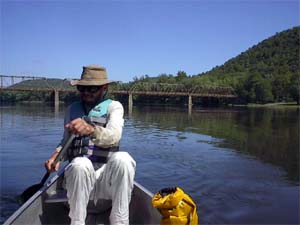 The first day we also passed under some bridges that have gained a fair amount of attention in recent years. Two bridges in the region have been selected for demolition and reconstruction. Before the process could begin, however, an environmental assessment found that living near these two bridges were the largest populations of northern riffleshell and clubshell mussels known in the world. Scientists have been working for five years studying these endangered species and carefully moving them so that they will not get harmed during the construction of the new bridges. According to an article published recently in the Sportsmen magazine, the lead scientist feels that the river is "very, very healthy" because of the large diversity in sizes she and her team have been finding. Pictured above is Morgan in front of the bridge in West Hickory where the mussells are being studied. Here are a few links for more information about the mussels: The first day we also passed under some bridges that have gained a fair amount of attention in recent years. Two bridges in the region have been selected for demolition and reconstruction. Before the process could begin, however, an environmental assessment found that living near these two bridges were the largest populations of northern riffleshell and clubshell mussels known in the world. Scientists have been working for five years studying these endangered species and carefully moving them so that they will not get harmed during the construction of the new bridges. According to an article published recently in the Sportsmen magazine, the lead scientist feels that the river is "very, very healthy" because of the large diversity in sizes she and her team have been finding. Pictured above is Morgan in front of the bridge in West Hickory where the mussells are being studied. Here are a few links for more information about the mussels:
http://www.post-gazette.com/pg/05241/561894.stm
http://www.paoutdoornews.com/articles/2005/09/22/news/news4.txt
|
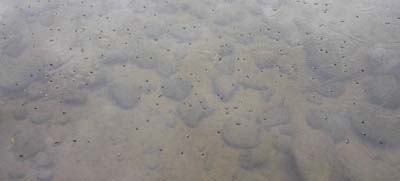 The next day we learned that even on the upper Allegheny in a canoe, the going can be tough. In Oil City we battled a class II rapid that didn't succeed in flipping the boat but did get the front of the canoe quite wet. Just past the city, the river straightened out, making a perfect tunnel for strong winds to build. It took us a fair amount of time to make that stretch downriver, paddling against such a strong force. Late that evening, an even stronger wind came up, which hollowed through the tent and brought with it rain that lasted for much of the next day. This slowed our progress quite a bit, but by the time we finished up the trip in Kenderdell Saturday morning we felt satisfied that we had obtained a better sense of river life along the upper Allegheny. It is the least developed river that we will be on during the journey, and we were reminded of this when we caught a glimpse of a bald eagle resting among the treetops. Another animal that accompanied us for much of the canoe trip were these tiny water boatmen, pictured above. They numbered in the thousands and would skitter along the surface of the water just out of the reach of the paddle as we moved down the river. The next day we learned that even on the upper Allegheny in a canoe, the going can be tough. In Oil City we battled a class II rapid that didn't succeed in flipping the boat but did get the front of the canoe quite wet. Just past the city, the river straightened out, making a perfect tunnel for strong winds to build. It took us a fair amount of time to make that stretch downriver, paddling against such a strong force. Late that evening, an even stronger wind came up, which hollowed through the tent and brought with it rain that lasted for much of the next day. This slowed our progress quite a bit, but by the time we finished up the trip in Kenderdell Saturday morning we felt satisfied that we had obtained a better sense of river life along the upper Allegheny. It is the least developed river that we will be on during the journey, and we were reminded of this when we caught a glimpse of a bald eagle resting among the treetops. Another animal that accompanied us for much of the canoe trip were these tiny water boatmen, pictured above. They numbered in the thousands and would skitter along the surface of the water just out of the reach of the paddle as we moved down the river.
|
| |
|
Read More About Next Week >>> |
|


 We were up early Sunday morning because we were hoping to get through five locks in one afternoon. The locks on the upper Allegheny are only open on the weekends for recreational purposes since there is little commercial traffic in the area, so we had a lot of ground to cover. It was a little after noon when we arrived at the first lock and pulled the rope that sounds a bell that alerts the lockmaster of a waiting boat. There was no response, so we pulled up to investigate and found that the operator had yet to arrive. A very friendly lockmaster showed up a little before one and apologized for his tardiness. He patiently delivered a quick lock tutorial and we were off. Or down, really. He first had to fill the chamber with water in order to get it at the same level as the upper part of the river. Then, very slowly, the doors opened. A light system very similar to stoplights is posted right next to the lock doors, and when the green light glows, it serves as the cue to enter the lock. When we got the signal, we undid our lines and headed for the lock. This lock is a little bit different from all other locks on the Upper Allegheny in that instead of using a line from the boat, ropes are provided; we simply had to hold on and slide our hands down the rope as the water level decreased. Once we were securely inside the lock, the doors were shut and the water level quickly started to drop. This lock was also special in that it is the deepest lock we have gone through so far. As you can see from the picture, the boat descended about 24 feet. In the photo above, Aimee is at the bow of the boat holding onto the lock lines as the door opens to leave the lock and proceed down the lower part of the river.
We were up early Sunday morning because we were hoping to get through five locks in one afternoon. The locks on the upper Allegheny are only open on the weekends for recreational purposes since there is little commercial traffic in the area, so we had a lot of ground to cover. It was a little after noon when we arrived at the first lock and pulled the rope that sounds a bell that alerts the lockmaster of a waiting boat. There was no response, so we pulled up to investigate and found that the operator had yet to arrive. A very friendly lockmaster showed up a little before one and apologized for his tardiness. He patiently delivered a quick lock tutorial and we were off. Or down, really. He first had to fill the chamber with water in order to get it at the same level as the upper part of the river. Then, very slowly, the doors opened. A light system very similar to stoplights is posted right next to the lock doors, and when the green light glows, it serves as the cue to enter the lock. When we got the signal, we undid our lines and headed for the lock. This lock is a little bit different from all other locks on the Upper Allegheny in that instead of using a line from the boat, ropes are provided; we simply had to hold on and slide our hands down the rope as the water level decreased. Once we were securely inside the lock, the doors were shut and the water level quickly started to drop. This lock was also special in that it is the deepest lock we have gone through so far. As you can see from the picture, the boat descended about 24 feet. In the photo above, Aimee is at the bow of the boat holding onto the lock lines as the door opens to leave the lock and proceed down the lower part of the river.  As the Libelula left the lock we got a good view of the water flowing down the dam and the closing lock doors. Boaters have to be careful going downriver where locks and dams are present because the dams can blend into the river. It is designed so that water simply spills over the side of a wall, and if one is not looking closely, it can look like the river is just continuing to flow. It is especially tricky since the locks, where the boats have to enter to pass down the river, are on the side of the dam next to the edge of the river. Luckily, signs are posted that warn boats of an approaching dam and the whole of the river near the dam is blocked off with buoys--except, of course, the little strip of water that leads to the locks.
As the Libelula left the lock we got a good view of the water flowing down the dam and the closing lock doors. Boaters have to be careful going downriver where locks and dams are present because the dams can blend into the river. It is designed so that water simply spills over the side of a wall, and if one is not looking closely, it can look like the river is just continuing to flow. It is especially tricky since the locks, where the boats have to enter to pass down the river, are on the side of the dam next to the edge of the river. Luckily, signs are posted that warn boats of an approaching dam and the whole of the river near the dam is blocked off with buoys--except, of course, the little strip of water that leads to the locks.  After passing through the lock, we looked at the time and realized that we were going to miss our window of opportunity to get through the other four locks that day unless we picked up some speed. With great reluctance, we dismounted the bikes, dropped the motor into the water, and in short order arrived at the second lock. All proceeded as planned until...the motor began to sputter just a few miles upriver from Lock #7 at Kittanning, which would have been our third lock of the day. A quick check of the fuel tank showed that the motor was not as fuel efficient as had been predicted by the mechanic: there was only a little bit of gasoline left. We hopped back on the bikes, but our progress was quite slow. The presence of dams severely limit the free movement of water, which causes the river to "pool" out, resulting in little to no flow in the river when there isn't much rain. Faced with the facts that we were moving quite slowly and the dams were going to be closed for the week, we decided to pedal to the nearest launch ramp, which was up Cowanshannock Creek in Gosford, and take the boat out of the water. A visit from a dragonfly resting atop the tent eased the frustrations we had about our current predicament.
After passing through the lock, we looked at the time and realized that we were going to miss our window of opportunity to get through the other four locks that day unless we picked up some speed. With great reluctance, we dismounted the bikes, dropped the motor into the water, and in short order arrived at the second lock. All proceeded as planned until...the motor began to sputter just a few miles upriver from Lock #7 at Kittanning, which would have been our third lock of the day. A quick check of the fuel tank showed that the motor was not as fuel efficient as had been predicted by the mechanic: there was only a little bit of gasoline left. We hopped back on the bikes, but our progress was quite slow. The presence of dams severely limit the free movement of water, which causes the river to "pool" out, resulting in little to no flow in the river when there isn't much rain. Faced with the facts that we were moving quite slowly and the dams were going to be closed for the week, we decided to pedal to the nearest launch ramp, which was up Cowanshannock Creek in Gosford, and take the boat out of the water. A visit from a dragonfly resting atop the tent eased the frustrations we had about our current predicament.  We foolishly thought that we had the situation under control, but the fates had other plans. Early the next morning after Morgan took his bike off of the boat, put some wheels on it, and headed off to retrieve the car and trailer which was parked about 25 miles upstream, Aimee heard some noises outside the boat and looked out to find a small team of Pennsylvania Fish and Game Commission employees hard at work unloading an earthmover and temporary fences. Upon further investigation, she found that they were there to tear up the ramp and replace it with a new one. It did look like a new ramp was in order, but the timing was most inconvenient. Luckily, the workers were sympathetic to our story and agreed to wait until Morgan had returned with the trailer. Meanwhile, the tire on Morgan's bike had popped and been torn to shreds about three miles from the car. He happened to be biking beside a local, however, who kindly offered to come back and collect Morgan with his car, which he did. Just as soon as Morgan arrived back to the boat with the trailer in tow, we hauled the boat out of the water. As the above picture shows, the next moment the crew was there with the earthmover, tearing the ramp up. What timing! We made the decision to return to Morgan's house in Somerset, PA in order to make a number of modifications that would hopefully help the boat move more efficiently through the water and increase our speed.
We foolishly thought that we had the situation under control, but the fates had other plans. Early the next morning after Morgan took his bike off of the boat, put some wheels on it, and headed off to retrieve the car and trailer which was parked about 25 miles upstream, Aimee heard some noises outside the boat and looked out to find a small team of Pennsylvania Fish and Game Commission employees hard at work unloading an earthmover and temporary fences. Upon further investigation, she found that they were there to tear up the ramp and replace it with a new one. It did look like a new ramp was in order, but the timing was most inconvenient. Luckily, the workers were sympathetic to our story and agreed to wait until Morgan had returned with the trailer. Meanwhile, the tire on Morgan's bike had popped and been torn to shreds about three miles from the car. He happened to be biking beside a local, however, who kindly offered to come back and collect Morgan with his car, which he did. Just as soon as Morgan arrived back to the boat with the trailer in tow, we hauled the boat out of the water. As the above picture shows, the next moment the crew was there with the earthmover, tearing the ramp up. What timing! We made the decision to return to Morgan's house in Somerset, PA in order to make a number of modifications that would hopefully help the boat move more efficiently through the water and increase our speed.  Before the modification work could begin in earnest, however, we wanted to cover some of the river that we had had to miss during the past week due to shallow water. The fourth grade teacher in Tionesta, Jim Knauff, had mentioned that we might be able to borrow his leaky canoe for such a venture, and a quick phone called proved that he was good on his word. Tuesday morning we visited the two schools along the river we had scheduled for that week in Freeport and Tarentum, PA and in the afternoon headed back up to Tionesta. Jim and his family treated us to a delightful evening, and in an interesting turn of events, he and his friend Ashley Sweda located a non-leaky canoe for us to borrow from the Tionesta Boy Scout troop #82; the same troop that we had stopped to visit the week before! Early the next morning, Ashley drove us up to Tidioute so that we could begin our journey where we first had to take the boat out of the water. In the picture above, Aimee ponders how to pack supplies so that they stay dry while Ashley lends some guidance.
Before the modification work could begin in earnest, however, we wanted to cover some of the river that we had had to miss during the past week due to shallow water. The fourth grade teacher in Tionesta, Jim Knauff, had mentioned that we might be able to borrow his leaky canoe for such a venture, and a quick phone called proved that he was good on his word. Tuesday morning we visited the two schools along the river we had scheduled for that week in Freeport and Tarentum, PA and in the afternoon headed back up to Tionesta. Jim and his family treated us to a delightful evening, and in an interesting turn of events, he and his friend Ashley Sweda located a non-leaky canoe for us to borrow from the Tionesta Boy Scout troop #82; the same troop that we had stopped to visit the week before! Early the next morning, Ashley drove us up to Tidioute so that we could begin our journey where we first had to take the boat out of the water. In the picture above, Aimee ponders how to pack supplies so that they stay dry while Ashley lends some guidance.  A delightful three days of canoeing followed. The first day we made it a good ways past Tionesta, stopping on an island to camp for the night amongst some very tall grass that made for a comfortable mattress. We paused in Tionesta to admire The Hunting and Fishing Museum of Pennsylvania. While the museum is still in its planning phase, a lighthouse has been erected to note the location from the river, pictured here to the right. It is a strange sight to find a lighthouse along the river. According to the museum staff in Tionesta, there are only four inland lighthouses in the state of Pennsylvania, the other three being found on Lake Erie.
A delightful three days of canoeing followed. The first day we made it a good ways past Tionesta, stopping on an island to camp for the night amongst some very tall grass that made for a comfortable mattress. We paused in Tionesta to admire The Hunting and Fishing Museum of Pennsylvania. While the museum is still in its planning phase, a lighthouse has been erected to note the location from the river, pictured here to the right. It is a strange sight to find a lighthouse along the river. According to the museum staff in Tionesta, there are only four inland lighthouses in the state of Pennsylvania, the other three being found on Lake Erie.  The first day we also passed under some bridges that have gained a fair amount of attention in recent years. Two bridges in the region have been selected for demolition and reconstruction. Before the process could begin, however, an environmental assessment found that living near these two bridges were the largest populations of northern riffleshell and clubshell mussels known in the world. Scientists have been working for five years studying these endangered species and carefully moving them so that they will not get harmed during the construction of the new bridges. According to an article published recently in the Sportsmen magazine, the lead scientist feels that the river is "very, very healthy" because of the large diversity in sizes she and her team have been finding. Pictured above is Morgan in front of the bridge in West Hickory where the mussells are being studied. Here are a few links for more information about the mussels:
The first day we also passed under some bridges that have gained a fair amount of attention in recent years. Two bridges in the region have been selected for demolition and reconstruction. Before the process could begin, however, an environmental assessment found that living near these two bridges were the largest populations of northern riffleshell and clubshell mussels known in the world. Scientists have been working for five years studying these endangered species and carefully moving them so that they will not get harmed during the construction of the new bridges. According to an article published recently in the Sportsmen magazine, the lead scientist feels that the river is "very, very healthy" because of the large diversity in sizes she and her team have been finding. Pictured above is Morgan in front of the bridge in West Hickory where the mussells are being studied. Here are a few links for more information about the mussels: The next day we learned that even on the upper Allegheny in a canoe, the going can be tough. In Oil City we battled a class II rapid that didn't succeed in flipping the boat but did get the front of the canoe quite wet. Just past the city, the river straightened out, making a perfect tunnel for strong winds to build. It took us a fair amount of time to make that stretch downriver, paddling against such a strong force. Late that evening, an even stronger wind came up, which hollowed through the tent and brought with it rain that lasted for much of the next day. This slowed our progress quite a bit, but by the time we finished up the trip in Kenderdell Saturday morning we felt satisfied that we had obtained a better sense of river life along the upper Allegheny. It is the least developed river that we will be on during the journey, and we were reminded of this when we caught a glimpse of a bald eagle resting among the treetops. Another animal that accompanied us for much of the canoe trip were these tiny water boatmen, pictured above. They numbered in the thousands and would skitter along the surface of the water just out of the reach of the paddle as we moved down the river.
The next day we learned that even on the upper Allegheny in a canoe, the going can be tough. In Oil City we battled a class II rapid that didn't succeed in flipping the boat but did get the front of the canoe quite wet. Just past the city, the river straightened out, making a perfect tunnel for strong winds to build. It took us a fair amount of time to make that stretch downriver, paddling against such a strong force. Late that evening, an even stronger wind came up, which hollowed through the tent and brought with it rain that lasted for much of the next day. This slowed our progress quite a bit, but by the time we finished up the trip in Kenderdell Saturday morning we felt satisfied that we had obtained a better sense of river life along the upper Allegheny. It is the least developed river that we will be on during the journey, and we were reminded of this when we caught a glimpse of a bald eagle resting among the treetops. Another animal that accompanied us for much of the canoe trip were these tiny water boatmen, pictured above. They numbered in the thousands and would skitter along the surface of the water just out of the reach of the paddle as we moved down the river.